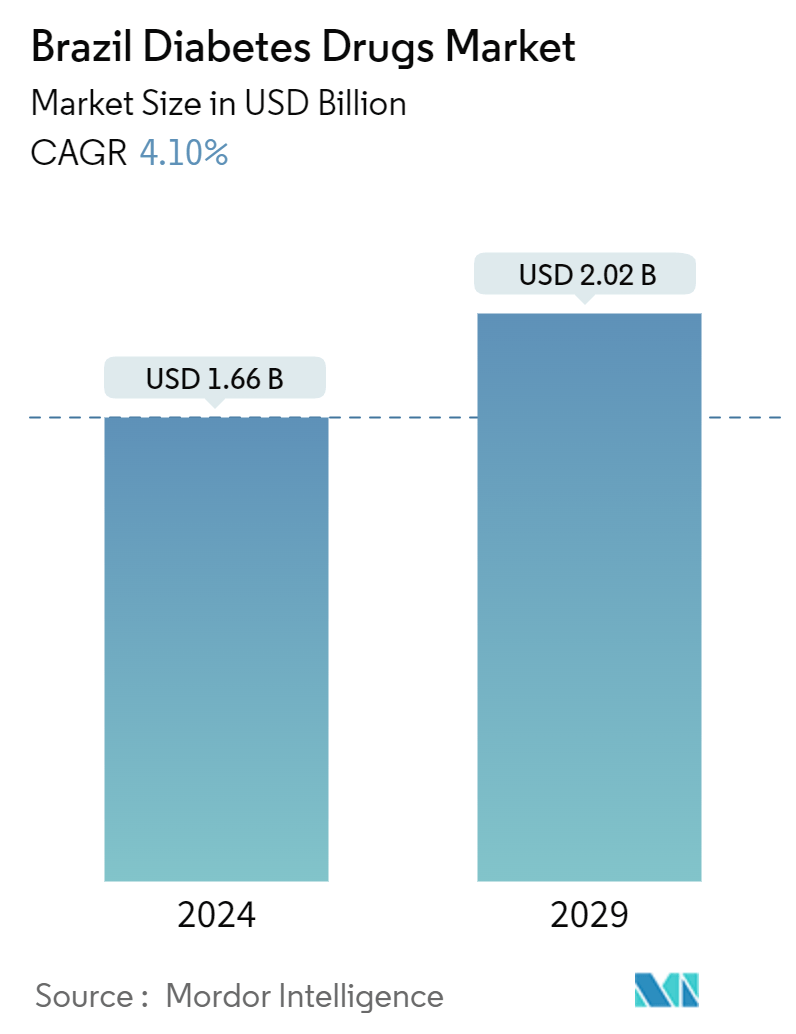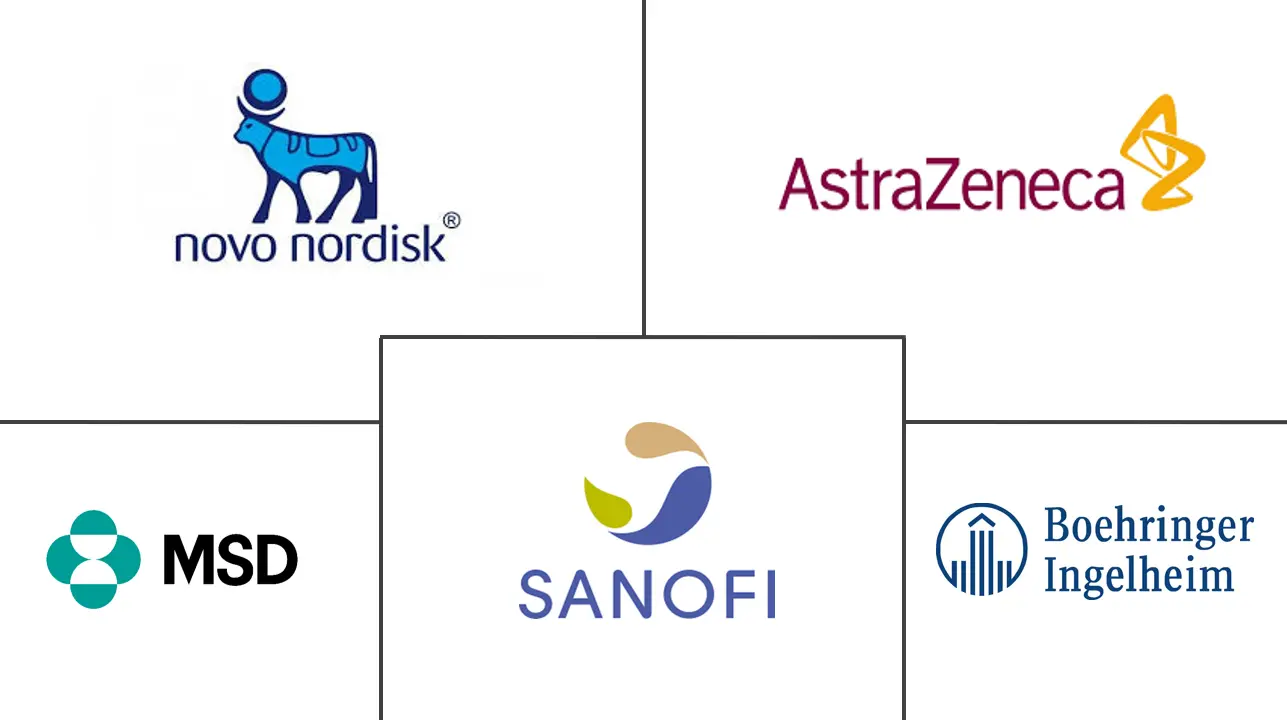Market Size of Brazil Diabetes Drugs Industry

| Study Period | 2018 - 2029 |
| Base Year For Estimation | 2023 |
| Forecast Data Period | 2024 - 2029 |
| Market Size (2024) | USD 1.66 Billion |
| Market Size (2029) | USD 2.02 Billion |
| CAGR (2024 - 2029) | 4.10 % |
Major Players
*Disclaimer: Major Players sorted in no particular order |
Brazil Diabetes Drugs Market Analysis
The Brazil Diabetes Drugs Market size is estimated at USD 1.66 billion in 2024, and is expected to reach USD 2.02 billion by 2029, growing at a CAGR of 4.10% during the forecast period (2024-2029).
Diabetes is a significant health problem and one of the extraordinary challenges for healthcare systems all over Brazil. The disease's growing incidence, prevalence, and progressive nature encouraged the development of new drugs to provide additional treatment options for diabetic patients. The roll-out of many new products, increasing international research collaborations in technology advancement, and increasing awareness about diabetes among people are some of the market opportunities for the players in the diabetes drugs market.
According to IDF Diabetes, 15.7 million adults about 10.5% are currently living with diabetes in Brazil or one in ten adults. The cost of diabetes-related health expenditure in Brazil is the third highest in the world, at 42.9 billion USD. In addition, 18 million adults around 11.9% have Impaired Glucose Tolerance which places them at high risk of developing type 2 diabetes. 32% of people living with diabetes in Brazil are undiagnosed. Additional data on glycaemic control in Brazil show that only 25% met the therapeutic goal of glycated hemoglobin (HbA1c) less than 7% before the pandemic, as recommended by the Brazilian Diabetes Society (SBD).
When diabetes is undetected or inadequately treated, people with diabetes are at risk of serious and life-threatening complications, such as heart attack, stroke, kidney failure, blindness, and lower-limb amputation. These result in reduced quality of life and higher healthcare costs and lead to a greater need for access to care.
Brazil has implemented a set of reforms over the past to improve the distribution of doctors, develop new forms of service organization, introduce new financing models, and implement a range of quality improvement initiatives and policy frameworks to overcome risk factors such as obesity and emerging pandemic threats. This also highlights opportunities for continuing and expanding innovations in the delivery of diabetes care.
Brazil Diabetes Drugs Industry Segmentation
Diabetes Drugs are used to manage diabetes mellitus by lowering the glucose level in the blood. The Brazil Diabetes Drugs Market is segmented into insulin drugs, oral anti-diabetic drugs, non-insulin injectable drugs, and combination drugs. The report offers the value (in USD) and volume (in units) for the above segments.
| Insulins | |||||||
| |||||||
| |||||||
| |||||||
|
| Oral Anti-diabetic drugs | ||||||
| ||||||
| ||||||
| ||||||
| ||||||
| ||||||
| ||||||
|
| Non-Insulin Injectable drugs | |||||||
| |||||||
|
| Combination drugs | |||||
| |||||
|
Brazil Diabetes Drugs Market Size Summary
The Brazil Diabetes Drugs Market is experiencing a significant transformation driven by the increasing prevalence of diabetes and the subsequent demand for effective treatment options. The market is characterized by the introduction of new drugs and the expansion of international research collaborations aimed at advancing diabetes care. The growing awareness of diabetes among the Brazilian population presents substantial opportunities for market players. The Brazilian healthcare system faces challenges due to the high incidence of undiagnosed diabetes and the need for improved glycaemic control. In response, the government has implemented reforms to enhance healthcare delivery, which includes partnerships with private companies to ensure affordable access to diabetes medications. This collaborative approach is expected to bolster the market's growth trajectory.
The market is moderately consolidated, with major pharmaceutical companies such as Eli Lilly, Sanofi, Novo Nordisk, and AstraZeneca playing pivotal roles. These companies are actively engaged in strategy-based mergers and acquisitions to expand their market presence and introduce innovative products. The introduction of new-generation oral anti-diabetic drugs, including DPP-4 and SGLT-2 inhibitors, is reshaping treatment paradigms by offering improved cardiovascular benefits and better patient adherence. The Brazilian public health system is also expanding its support for diabetes patients, further driving market growth. Recent regulatory approvals, such as tirzepatide by Eli Lilly, highlight the ongoing advancements in diabetes treatment options, positioning Brazil as a key market for diabetes drugs in the coming years.
Brazil Diabetes Drugs Market Size - Table of Contents
-
1. MARKET DYNAMICS
-
1.1 Market Overview
-
1.2 Market Drivers
-
1.3 Market Restraints
-
1.4 Porter's Five Forces Analysis
-
1.4.1 Bargaining Power of Suppliers
-
1.4.2 Bargaining Power of Consumers
-
1.4.3 Threat of New Entrants
-
1.4.4 Threat of Substitute Products and Services
-
1.4.5 Intensity of Competitive Rivalry
-
-
-
2. MARKET SEGMENTATION
-
2.1 Insulins
-
2.1.1 Basal or Long Acting Insulins
-
2.1.1.1 Lantus (Insulin Glargine)
-
2.1.1.2 Levemir (Insulin Detemir)
-
2.1.1.3 Toujeo (Insulin Glargine)
-
2.1.1.4 Tresiba (Insulin Degludec)
-
2.1.1.5 Basaglar (Insulin Glargine)
-
-
2.1.2 Bolus or Fast Acting Insulins
-
2.1.2.1 NovoRapid/Novolog (Insulin Aspart)
-
2.1.2.2 Humalog (Insulin Lispro)
-
2.1.2.3 Apidra (Insulin Glulisine)
-
-
2.1.3 Traditional Human Insulins
-
2.1.3.1 Novolin/Actrapid/Insulatard
-
2.1.3.2 Humulin
-
2.1.3.3 Insuman
-
-
2.1.4 Biosimilar Insulins
-
2.1.4.1 Insulin Glargine Biosimilars
-
2.1.4.2 Human Insulin Biosimilars
-
-
-
2.2 Oral Anti-diabetic drugs
-
2.2.1 Biguanides
-
2.2.1.1 Metformin
-
-
2.2.2 Alpha-Glucosidase Inhibitors
-
2.2.2.1 Alpha-Glucosidase Inhibitors
-
-
2.2.3 Dopamine D2 receptor agonist
-
2.2.3.1 Bromocriptin
-
-
2.2.4 SGLT-2 inhibitors
-
2.2.4.1 Invokana (Canagliflozin)
-
2.2.4.2 Jardiance (Empagliflozin)
-
2.2.4.3 Farxiga/Forxiga (Dapagliflozin)
-
2.2.4.4 Suglat (Ipragliflozin)
-
-
2.2.5 DPP-4 inhibitors
-
2.2.5.1 Onglyza (Saxagliptin)
-
2.2.5.2 Tradjenta (Linagliptin)
-
2.2.5.3 Vipidia/Nesina(Alogliptin)
-
2.2.5.4 Galvus (Vildagliptin)
-
-
2.2.6 Sulfonylureas
-
2.2.6.1 Sulfonylureas
-
-
2.2.7 Meglitinides
-
2.2.7.1 Meglitinides
-
-
-
2.3 Non-Insulin Injectable drugs
-
2.3.1 GLP-1 receptor agonists
-
2.3.1.1 Victoza (Liraglutide)
-
2.3.1.2 Byetta (Exenatide)
-
2.3.1.3 Bydureon (Exenatide)
-
2.3.1.4 Trulicity (Dulaglutide)
-
2.3.1.5 Lyxumia (Lixisenatide)
-
-
2.3.2 Amylin Analogue
-
2.3.2.1 Symlin (Pramlintide)
-
-
-
2.4 Combination drugs
-
2.4.1 Insulin combinations
-
2.4.1.1 NovoMix (Biphasic Insulin Aspart)
-
2.4.1.2 Ryzodeg (Insulin Degludec and Insulin Aspart)
-
2.4.1.3 Xultophy (Insulin Degludec and Liraglutide)
-
-
2.4.2 Oral Combinations
-
2.4.2.1 Janumet (Sitagliptin and Metformin)
-
-
-
Brazil Diabetes Drugs Market Size FAQs
How big is the Brazil Diabetes Drugs Market?
The Brazil Diabetes Drugs Market size is expected to reach USD 1.66 billion in 2024 and grow at a CAGR of 4.10% to reach USD 2.02 billion by 2029.
What is the current Brazil Diabetes Drugs Market size?
In 2024, the Brazil Diabetes Drugs Market size is expected to reach USD 1.66 billion.

